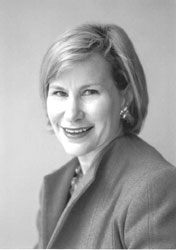|
 Profiles
in Education Profiles
in Education
Laurie Tisch-Sussman: Creative Solutions to Art Education’s
Woes
by Marie
Holmes
Laurie
Tisch-Sussman has always had an idealistic streak.
“At
the University of Michigan I kind of majored in the anti-war
effort,” she says. Sussman graduated, with a degree in
education, “thinking I was going to stop the war.”
Friends joked at the time that her efforts had been a little
too successful, for the war soon did come to an end, leaving
Sussman without her cause.
She then moved to Park City, Utah to become a “ski bum.”
“I didn’t know what [that] was, but I knew that
no one else in my family had done it.”
Fired from her waitressing job–“I still had that
kind of rebel thing”–Sussman found work as a substitute
teacher, then as a full-time Spanish teacher. She became involved
with the Kimball Arts Center in Park City, helping out with
fundraising efforts.
After five years of “ski-bumming,” teaching, and
fundraising, Sussman came to New York, where she worked in advertising,
sales and promotions and eventually married.
She remembers having a conversation with a friend when her daughter
was a few months old and voicing “that familiar moan of
women with children–should I work full time? Part time?”

The friend mentioned a fledgling institution then known as the
Manhattan Laboratory Museum (now the Children’s Museum
of Manhattan–CMOM). As it has to many other mothers of
young children, the flexible schedule and community focus of
the non-profit world appealed to Sussman. She served as Chairperson
of the museum’s board for over a decade, overseeing its
dramatic growth, and still serves as Honorary Chair.
In the mid-nineties, the Annenberg grants made news in the New
York “foundation world.” A program to create small
schools was the first effort in the city funded by the Annenberg
foundation, which had pledged $500 million to public education.
At the time, there was some talk about a second Annenberg program
focusing on the humanities.
Then Commissioner Chapin pitched the idea to secure Annenberg
funds to put arts back into the schools to Chancellors Cortines
and Crew. Chapin was persistent, says Sussman, and then
Schools Chancellor Rudy Crew was supportive of the plan. A firm
called Art Visions was hired with funding secured from the Diamond
Foundation to prepare a proposal to the Annenberg Foundation.
Hollis Hendrick came on board as Executive Director after the
Foundation awarded its challenge grant. Sussman was asked to
chair the newly formed Center for Arts Education.
“I
was really kind of ready not to do it,” she recalls. “I
didn’t really want to take on anything that big.”
When proposing the plan to education professionals, “everybody
said, ‘great idea, impossible execution.’”
But with the encouragement of friends, Sussman finally agreed
to steer the effort.
From 1996-2001 the group managed to raise $24 million
in public and private funds from the Board of Education, Department
of Cultural Affairs and private donors to secure Annenberg’s
two-for-one matching grant. In the first grant round in 1997
over 400 schools submitted proposals.
To apply for a grant from the Center for Arts Education, schools
are required to describe, in a formal proposal, how they plan
to partner with existing cultural institutions to enhance their
arts curriculum as well as how they will sustain these programs
after the grants run out. During the first 5 years, the
Center for Arts Education awarded over $21 million to 81 school
partnerships.
The
Center for Arts Education has expanded its activities to include
parents as partners, a grants program where parents and children
participate in arts activities in their schools. There is also
an internship program that places high school students in arts-related
businesses and organizations. Two years ago the Center launched
the “4 R’s” advertising campaign (subway posters
read, for example, “Reading, Writing, Arithmetic, Rhythm”)
designed to raise public awareness.
Prepared to close in 2001 when the Annenberg funding ended,
focus groups and casual conversations convinced Sussman and
her co-workers that they should stick around.
That left the question of money, and whether the new schools
chancellor would offer BOE funds. Based on the Center’s
new strategic plan, Chancellor Levy pledged $2.5 million. Donations
from private foundations and individuals followed which earned
the Center extended funding in the form of a one-to-one “challenge”
grant.
This June, the Center awarded 31 new schools with three-year
grants of $100,000. At PS 142, artists from Inside Broadway
and Mark DeGarmo and Dancers will set up residencies, hold professional
development workshops and perform for the students. At the High
School of Communication and Technology, dancers from Dance Wave
will teach dance to the students during their physical education
classes and will train teachers in dance instruction. Partnership
institutions range from small to large and are spread throughout
the boroughs, from the New York City Philharmonic to the Snug
Harbor Cultural Center in Staten Island.
“It’s
lunacy that you’ve got this city and no arts education,”
says Sussman. “It is like growing up in Bermuda and not
learning how to swim.” She believes that even modest funds
can help “marshal the resources.”
“We’re
in a pretty daunting fiscal situation right now,” she
says, acknowledging that Chancellor Klein and other city officials
are facing difficult decisions. “But I think it would
be difficult to cut the arts again. There’s too much awareness.”#

Education
Update, Inc., P.O. Box 20005, New York, NY 10001.
Tel: (212) 481-5519. Fax: (212) 481-3919.Email: ednews1@aol.com.
All material is copyrighted and may not be printed without express
consent of the publisher. © 2002.
|
